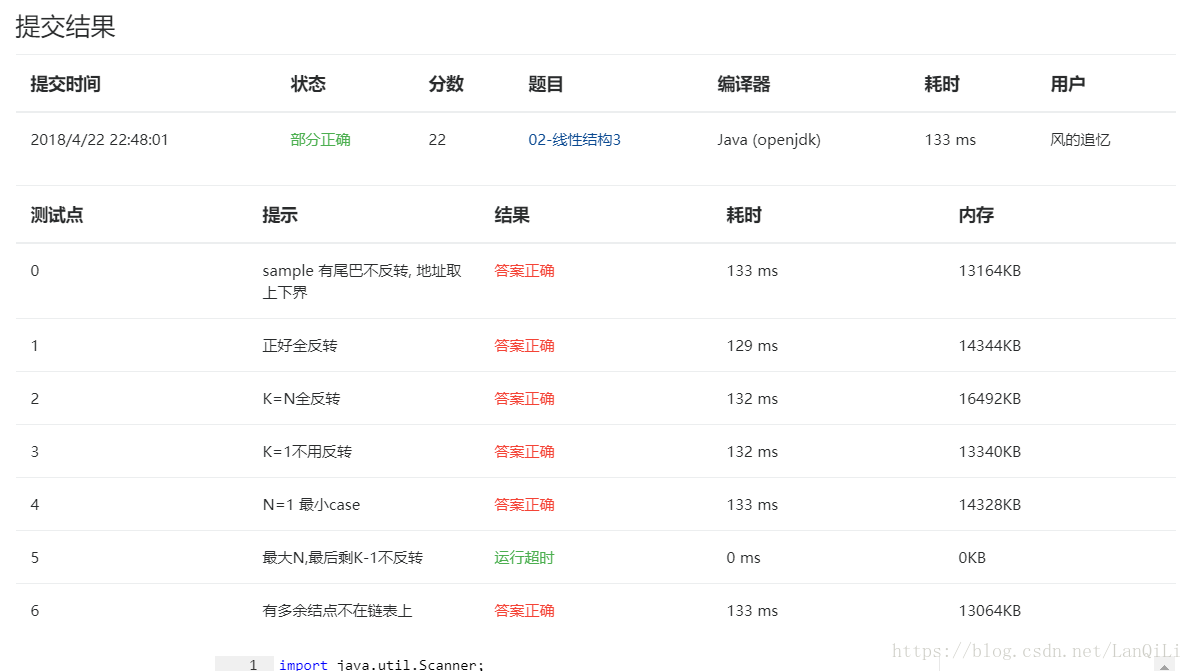02-线性结构3 Reversing Linked List(25 分)
Given a constant K and a singly linked list L, you are supposed to reverse the links of every K elements on L. For example, given L being 1→2→3→4→5→6, if K=3, then you must output 3→2→1→6→5→4; if K=4, you must output 4→3→2→1→5→6.
Input Specification:
Each input file contains one test case. For each case, the first line contains the address of the first node, a positive N (≤105) which is the total number of nodes, and a positive K (≤N) which is the length of the sublist to be reversed. The address of a node is a 5-digit nonnegative integer, and NULL is represented by -1.
Then N lines follow, each describes a node in the format:
Address Data Next
where Address is the position of the node, Data is an integer, and Next is the position of the next node.
Output Specification:
For each case, output the resulting ordered linked list. Each node occupies a line, and is printed in the same format as in the input.
Sample Input:
00100 6 4
00000 4 99999
00100 1 12309
68237 6 -1
33218 3 00000
99999 5 68237
12309 2 33218
Sample Output:
00000 4 33218
33218 3 12309
12309 2 00100
00100 1 99999
99999 5 68237
68237 6 -1import java.util.Scanner;
//创建一个结点
class node{
int data;//暂时忽略00xxx的状况,实在不会
int next;
}
class Main{
public static void main(String []args){
Scanner scan = new Scanner(System.in);
int head = scan.nextInt();
int N = scan.nextInt();
int K = scan.nextInt();
int head1 = head;
node []array = new node[100000];
for(int i=0;i<N;i++){//将所有的数据存储在数组中
int node = scan.nextInt();
array[node] = new node();
array[node].data = scan.nextInt();
array[node].next = scan.nextInt();
}
N = number(array,head);
if(K>1){
head1 = reverse(array,N,K,head);
}
print(head1,array);
}
//返回与链表相连的结点的个数,因为有些结点可能不与链表相连,不需要逆转
public static int number(node []array,int head){
int number = 1;
while(head!=-1){
head = array[head].next;
number++;
}
return number;
}
//返回需要逆转的头结点,同时逆转链表
public static int reverse(node []array,int N,int K,int head){
int remain = head;
int remain2 = head;
int new_head = head;
int old_head = array[new_head].next;
int temp;
int number = 1;
int reverse = 1;
while(reverse<=N/K){//判断逆转的次数
while(number<K){
temp = array[old_head].next;
array[old_head].next = new_head;
new_head = old_head;
old_head = temp;
number++;
}
if(reverse==1){
array[remain].next = old_head;
head = new_head;
}
else{
array[remain].next = new_head;
remain = remain2;
}
if(old_head==-1){
array[remain2].next = -1;
}
else{
new_head = old_head;
old_head = array[old_head].next;
remain2 = new_head;
}
number = 1;
reverse++;
}
return head;
}
//因为开头是五位数,所以前面不足的地方得补0
public static String transform(int k){
String s = "00000";
String first =k+"";
int length = first.length();
s = s.substring(length)+first;
if(k ==-1){
return k+"";
}
return s;
}
//打印链表
public static void print(int head,node []array){
while(head!=-1){
String head1 = transform(head);
String next1 = transform(array[head].next);
System.out.println(head1+" "+array[head].data+" "+next1);
head = array[head].next;
}
}
}







 本文介绍了一种链表逆序算法的实现方法,通过Java编程语言详细展示了如何按照指定长度逆序链表中的节点,并提供了完整的代码示例及运行结果。
本文介绍了一种链表逆序算法的实现方法,通过Java编程语言详细展示了如何按照指定长度逆序链表中的节点,并提供了完整的代码示例及运行结果。
















 1229
1229

 被折叠的 条评论
为什么被折叠?
被折叠的 条评论
为什么被折叠?








